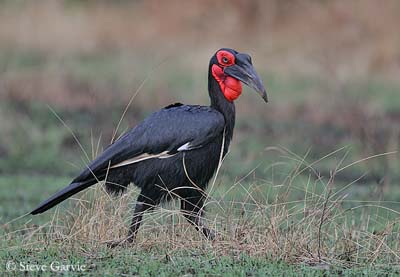
FAMILY BUCEROTIDAE AND BUCORVIDAE
HORNBILLS
Hornbills are strange and beautiful birds, often incorporated in local cultures. In Africa, they are respected by people and involved in mythology and folklores.
But hornbills are also associated with medical and religious traditions. In India and South-east Asia, hornbills of the genus Buceros were often included into numerous myths and rituals. Indian people used skulls, casques and tail feathers as ornaments.
All these peoples were impressed by the beak and the casque of most of the species, and particularly of the largest hornbills.
Today, these birds are often featured as emblems in several Asian and African countries.
Hornbills belong to the Order Bucerotiformes. This order gathers the Ground Hornbills (only two species of the genus Bucorvus, family Bucorvidae), and the typical Hornbills, mostly arboreal (59 species, family Bucerotidae).
Related article :
The bird and its nest, where everything starts…
Page 15: Upupidae, Phoeniculidae, Bucerotidae and Bucorvidae
Photographers :
John Anderson : John Anderson Photo Galleries
Didier Buysse : Vision d’Oiseaux
Steve Garvie : RAINBIRDER Photo galleries
Tom Merigan : Tom Merigan’s Photo Galleries
William Price : PBase-tereksandpiper & Flickr William Price
Dubi Shapiro : Dubi Shapiro Photo Galleries
Callie de Wet : GALLERY
Text and illustration by Nicole Bouglouan
Sources :
HANDBOOK OF THE BIRDS OF THE WORLD Vol 6 by Josep del Hoyo-Andrew Elliott-Jordi Sargatal - Lynx Edicions, 2001 - ISBN: 848733430X
BIRDS OF AFRICA SOUTH OF THE SAHARA by Ian Sinclair and Peter Ryan - Princeton University Press Princeton and Oxford - ISBN: 0691118159
Wikipedia (Wikipedia, The Free Encyclopaedia)
CREAGUS@Monterey Bay (Don Roberson)
Fatbirder - The World’s Richest Information Resource about Birds for Birders

Bucorvus leadbeateri
The Ground Hornbills are the largest members of the order. They live in the open savannahs of the Sub-Saharan Africa.
We find the Northern Ground-hornbill and the Southern Ground Hornbills. Both are terrestrial species but they are able to fly very well. They have long legs adapted to their hunting behaviour. They hunt while walking on the ground and they are mainly carnivorous.
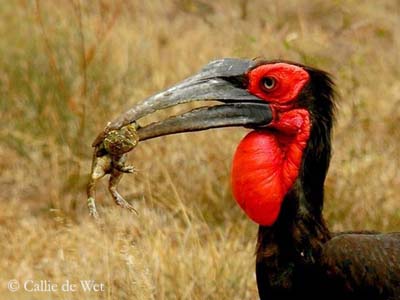
Bucorvus leadbeateri
The Ground Hornbills nest in natural cavities but they do not seal the entrance and the female may come and go freely during the nesting period.
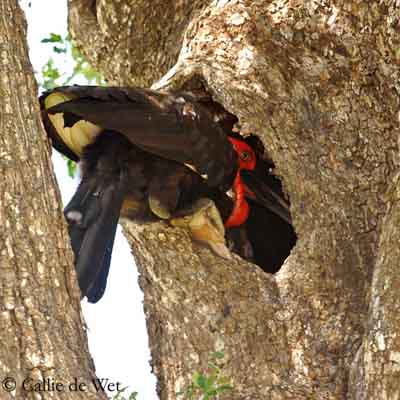
Bucorvus leadbeateri
Both species are found in Africa and live in restricted range and reserves. They are threatened by habitat loss, but they are locally common.
Ground Hornbills belong to the subfamily Bucorvinae, family Bucorvidae.
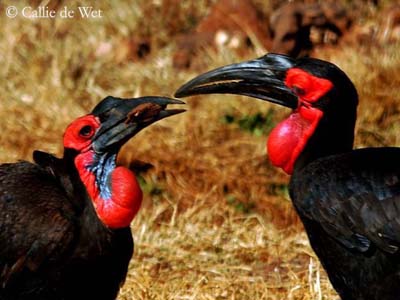
The other species belong to the family Bucerotidae, with 15 genera.
The largest genus is the African Tockus. These hornbills are the smallest of all species, living mainly in savannahs and woodlands. They bring one single prey at time in the bill tip to the nest.
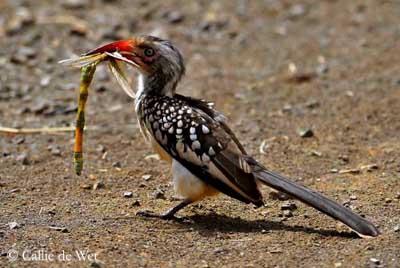
Tockus erythrorhynchus
These hornbills are known for their conspicuous territorial displays accompanied by varied sounds, from whistles to clucks according to the species.
The “whistlers” have short legs and hop on the ground. Their long wings produce a buoyant floating flight.
The “cluckers” have longer legs and walk on the ground. However, their shorter wings give direct flap-and-glide flight.
Within the Tockus group, the genus Tropicanus includes only one species, the White-crested Hornbill (Tropicanus albocristatus). This one flies as a large flycatcher through the low forest canopy, steered by the very long, graduated tail. It shows conspicuous white crest. Its howling calls make it different from other hornbills.
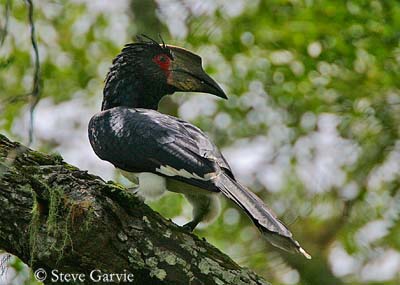
Bycanistes bucinator
The last two African genera are Bycanistes and Ceratogymna, with seven species of forest hornbills. They are medium-sized and mainly black in colour, with white areas on body, wing tips and tail.
The males of both genera show much larger casque than in female, and these casques are among the largest of all the Bucerotidae. They utter loud nasal calls, thanks to the large casque compared to a resonance chamber.
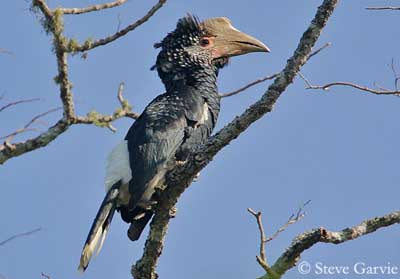
Bycanistes brevis
These two genera are mostly similar to the Asian hornbills, living in forested areas and feeding mainly on fruit. They bring several fruits in the oesophagus to the nest where they regurgitate one item at time.
In these genera, the male swallows mud and forms it into pellets. It regurgitates them to the female for sealing the nest entrance.
The similarities of behaviour and morphology between these two genera could be a good reason for ending into a single genus Ceratogymna because they are closely related.
Numerous approaches for the classification of hornbills indicate that no genera of hornbills have members in both Africa and Asia.
The three members of Ocyceros have been united with the small African Tockus, but they differ in several behaviours. Only one species, the Indian Grey Hornbill (Ocyceros birostris) is a savannah-dwelling hornbill in Asia. All other species are forest hornbills.
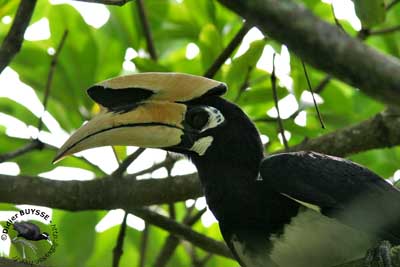
Northern Pied Hornbill
Anthracoceros albirostrus
This species shares elongated central rectrices with several species of the genus Anthracoceros which contains five species slightly similar to the African Bycanistes and Ceratogymna.
They have black and white plumage and large casque, with almost same size of casque in both sexes. Male and female are very similar but they differ in bill colour and bare skin around the eyes.
They are spread across a wide area, from Western India, through South-east Asia to Sumatra and Borneo.
The three species of genus Buceros and the single one of Rhinoplax are the largest of the Asian hornbills, and they have wide range too, from Western India to Sumatra, Java, Borneo and the Philippines.
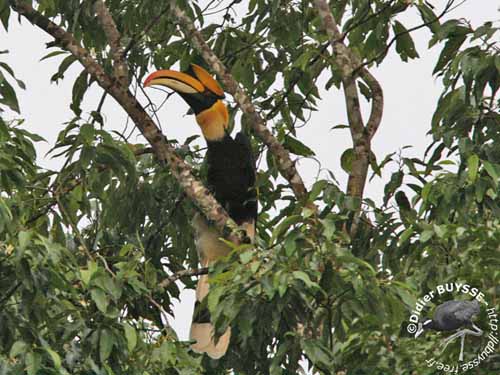
Buceros bicornis
In these species, both sexes share the same size of casque and bill, but each species has its own form. These differences are probably used in displays. Casques and bills are coloured bright red, yellow or orange, due to the coloured oils from the preen gland, situated at the base of the tail.
The Helmeted Hornbill (Rhinoplax vigil) differs of these Buceros in some details such as markedly elongated central rectrices, casque structure and complex sounds, although it shares many features with them, and is sometimes considered as congeneric.
In the remaining five genera of Asian hornbills, we can find the smallest genus Anorrhinus which gathers three species. They are medium-sized birds with bushy head feathers.
The two brown species are found on the Asia mainland. The third species, the Bushy-crested Hornbill (Anorrhinus galeritus) is found in the Sunda region which includes the Malay Peninsula and the adjacent Sumatra and Borneo Islands.
These three species utter loud cackling calls. They live in small groups and breed cooperatively within the group.
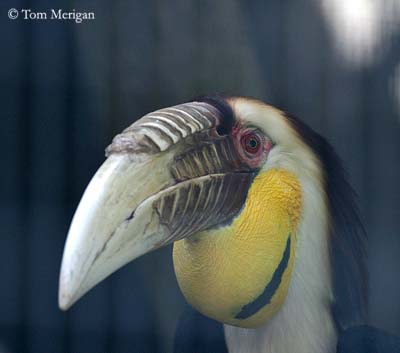
Wreathed Hornbill
Rhyticeros (Aceros) undulatus
The genus Penelopides contains five small species distinguished by the plate-like structure at mandible base, ridged with transverse bars. Some larger hornbills Aceros and Rhyticeros show this particularity too. Females have all-black (or dark) body plumage.
The genus Penelopides is found on the Indonesian island of Sulawesi, and on several islands of the Philippine Archipelago.
The other three Asian genera contain eleven species, from medium-sized to large hornbills, and females also have all-black or dark body plumage. They occur from Nepal and eastern India, eastwards to the Philippines and southwards to the Salomon Islands.
Aceros and Rhyticeros feed mainly on fruit and travel long distances for food. They may gather in large flocks at rich food sources and at night-time roosts.
Because they share several similarities in plumage and behaviour, Aceros and Rhyticeros, and the monospecific Berenicornis have been merged by some authors, such as Kemp in 1995.
The Asian hornbill, White-crowned Hornbill (Berenicornis comatus) lacks casque, but shows bushy white crest and long, graduated white tail. This species is sedentary and lives in small groups where they breed cooperatively.
This hornbill has its own genus Berenicornis, alongside the Anorrhinus species. Both have bushy crests and breed within the group.
All these genera and different species have several common features and behaviours.
About the physical description, the main common feature is the bill. It is always large, more or less long or thick, but strong, with casque or not. Male is always larger than female in size. Their plumage varies from black, white, grey to brown or cream. They show some distinctive patterns in flight.
Usually, the bare parts are brightly coloured on face and throat.
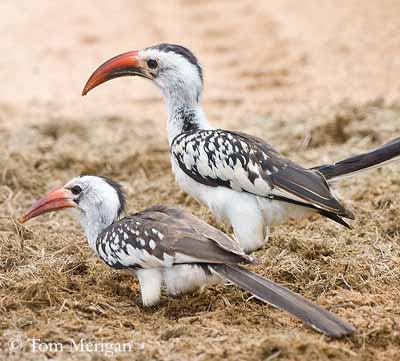
Tockus erythrorhynchus
The casque is unique to the hornbills. It varies according to the species, showing a diversity of forms even among the members of the family. The development of this casque may last up to six years to be finished.
It is a hollow structure which functions as a resonating chamber, giving the loud nasal sounds uttered by large hornbill species.
In the species with small casque, the throat may inflate and play a role in the calls.
Bill and casque are used in aerial disputes between rival males. The bill is also used to chisel off bark. And the size of bill and casque may help to differentiate male and female.
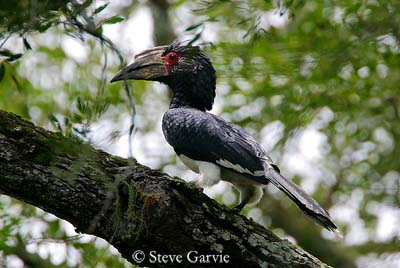
Bycanistes bucinator
Hornbills usually perform strong flight with slow, deep wing beats, and short glides. According to the length of the wings, some species such as the Indian Grey Hornbill (Ocyceros birostris) which has very short wings perform fast wing beats and little gliding.
On the ground, the short-legged hornbills move by hops, whereas the long-legged birds walk. They also perform long hops among branches.
Most hornbills feed on animal and vegetal items, but they feed mainly on fruit and small animals, depending on the availability of food resources.
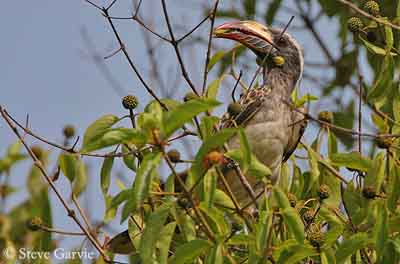
African Grey Hornbill
Tockus nasutus
Hornbills often hunt with mammals, taking advantage of insects disturbed by these mammals. They defend their feeding areas.
They use the bill to take the food, picking up food where it is found, or lifting leaves for hidden preys, or digging into the soil and under the bark. They snatch hanging fruit or insects from vegetation or the ground while flying, and hawk aerial preys. They may swallow it whole but larger items are broken up.
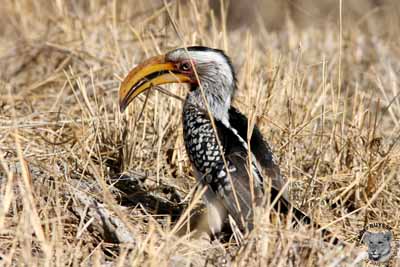
Southern Yellow-billed Hornbill
Tockus leucomelas
Hornbills nest in natural cavities, usually in trees but also in rock faces. The final selection is made by the female. The male often assists her, bringing food and nest materials.
The pair becomes territorial and defends the nest-site. The colours of the bare facial skin become brighter and are used in displays. Male frequently performs courtship-feeding.
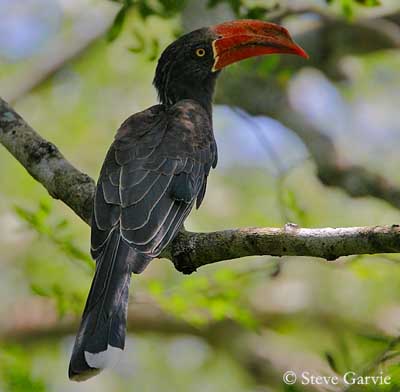
Tockus alboterminatus
The female may spend long periods in the nest before to seal it, arranging the cavity. These behaviours may last several months until the conditions for breeding become suitable.
At this moment, the female seals herself the nest, forming an elongated vertical slit. Female sits in the nest and lays the eggs some days later. She lays one or two eggs in the large species, and up to eight for some small Tockus species. During the nesting period, the female moults.
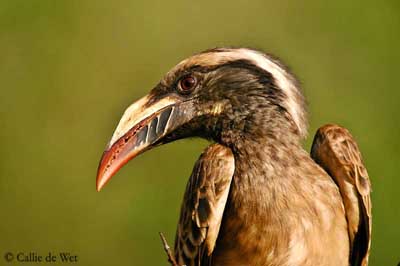
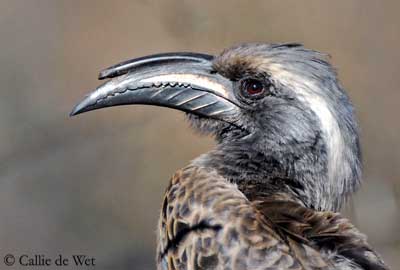
African Grey Hornbill - Tockus nasutus - Male and female
Incubation lasts from 23 to 42 days, according to the species. The smallest chicks often die of starvation.
The male brings food to the nest. In cooperative breeders, he has helpers.
The nestling period may lasts from 39-50 days for small species, to 72-96 days in the largest. The female emerges at the end of the nesting cycle. At this moment, she pecks away from within with the bill and needs some hours to remove sufficient material.
Female and chicks fly immediately and do not return to the nest until the next season. The young remain around the nest for some days or weeks, and are fed by both parents. Then, they follow the adults for foraging.
Almost all the hornbill species seal the nest, except the two species of the genus Bucorvus.
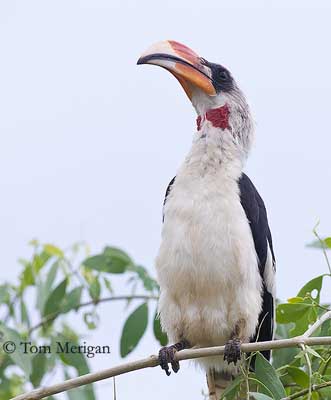
Tockus deckeni
Hornbills utter loud calling at any time of the day. In dense habitat, calls are used as contact between them. Territorial hornbills employ them as advertising calls in defended area, and much more during the breeding season.
Both mates may call in unison, and these sounds accompany active displays such as head bowed down, or bill raised skywards, or fanned wings and tail.
The ground-hornbills utter booming calls that may be audible at up to five kilometres. The Helmeted Hornbill (Buceros vigil) has an unique call, a rapid series of single hoots ending into loud cackling laughter. It is one of the loudest calls of any bird!
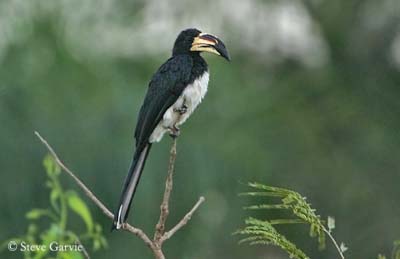
Pied Hornbill
Tockus fasciatus
The range of hornbills is simple: twenty three species are living in Africa south of the Sahara, where they frequent deciduous forests and savannahs.
The other thirty species are living in India and South-east of Asia, in forest habitat. Only one species, the Indian Grey Hornbill (Ocyceros birostris) lives in savannahs. Hornbills are sedentary.
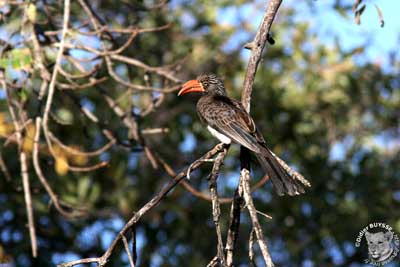
Tockus alboterminatus
Hornbills are threatened by habitat loss across the entire range, with too many changes in their areas. The deforestation has been accelerated, involving the lack of nesting cavities in large trees. All the forest species are highly threatened and in decline.
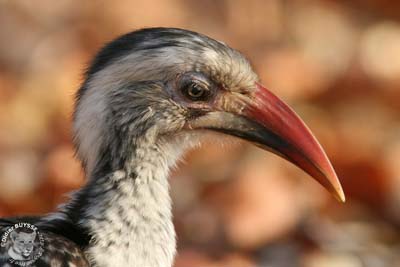
Tockus erythrorhynchus
Several species are living in restricted range such as a single island or an archipelago, and have small populations. Nine species are currently threatened, all from the Oriental Region.
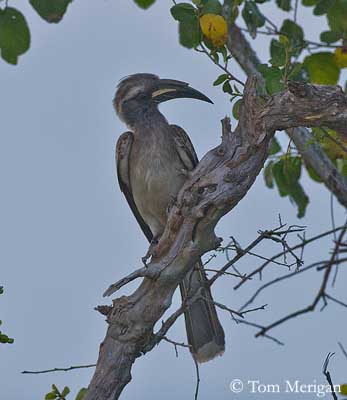
African Grey Hornbill
Tockus nasutus
Update of this article at
the bottom of the page
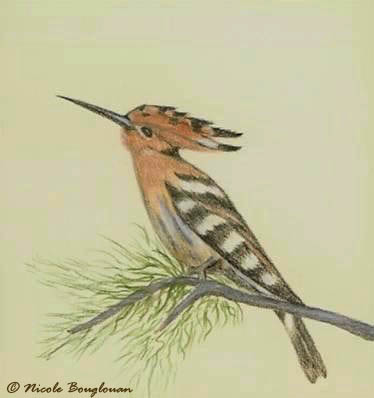
UPDATE OF THIS PAGE
FAMILY PHOENICULIDAE
Wood hoopoes and scimitarbills
The order Bucerotiformes includes now two more families, formerly placed in the order Coraciiformes. They are the family Phoeniculidae (wood hoopoes and scimitarbills) and the family Upupidae (hoopoes).
These species nest in tree cavities, but only the hornbills of family Bucerotidae seal the nest entrance.
The family Phoeniculidae is that of the typical wood hoopoes in the subfamily Phoeniculinae, and of the scimitarbills and the Black-billed Wood Hoopoe in the subfamily Rhinopomastinae.
They are medium-sized arboreal birds, usually with iridescent black plumage, some white in wings and tail (or not), long, decurved bill well-adapted to their behaviour of capturing prey in bark crevices.
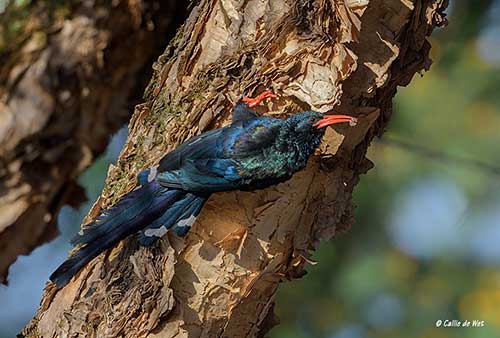
Both wood hoopoes and scimitarbills are found in Sub-Saharan Africa and are not migratory. They frequent wooded habitats from tropical lowland rainforest to arid bush country. They need trees, first because they are tree-foraging specialists, and second, they require tree cavities for nesting and nocturnal roosting sites.
They feed primarily on arthropods of various species, but they also take spiders, millipedes, centipedes, larval and adult insects and also their eggs. Berries and seeds are also part of their diet.
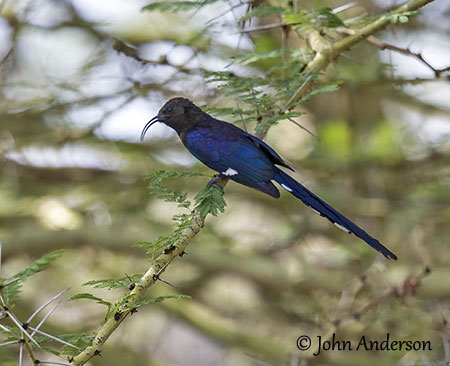
Common Scimitarbill
Rhinopomastus cyanomelas
They are specialized for foraging on tree trunks, limbs and small branches in trees. The bill resembles curved forceps, allowing the birds to reach prey in bark crevices. The short but thick tarsi and the strong toes with long, well-curved claws are also adapted to this behaviour.
Wood hoopoes and scimitarbills are noisy birds, and vocalizations are one of the most conspicuous aspects of their behaviour. However, the three species of genus Rhinopomastus and the Forest Wood Hoopoe are less social and have softer calls.
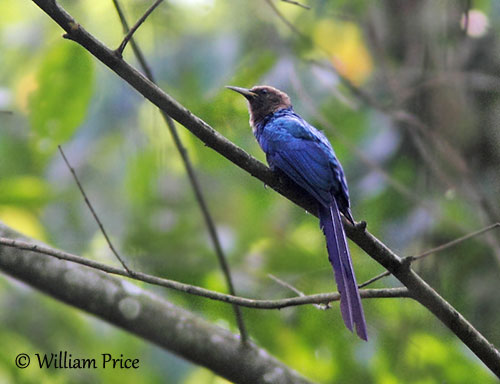
Forest Wood Hoopoe
Phoeniculus castaneiceps
The Phoeniculidae species nest in tree-cavities such as natural hollows or holes excavated by woodpeckers or barbets. The nest is usually unlined.
The three members of the genus Rhinopomastus breed as pairs with only a single male and a single female sharing the nesting duties.
On the other hand, the Phoeniculus species (except for, possibly, the Forest Wood Hoopoe which is poorly known), engage in co-operative breeding involving the presence of both breeding and mature non-breeding individuals in a social flock. The non-breeders are usually “helpers”. After fledging, the young are fed and protected by the entire flock.
It is suspected that all Phoeniculidae species are monogamous.
The wood hoopoes and the scimitarbills are not globally threatened and currently, there are no immediate conservation concerns.
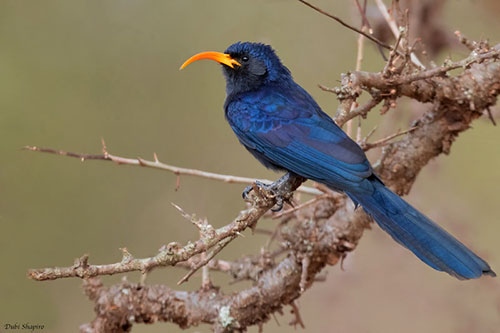
Abyssinian Scimitarbill
Rhinopomastus minor
UPUPIDAE FAMILY
See here: Family Upupidae (Hoopoes)